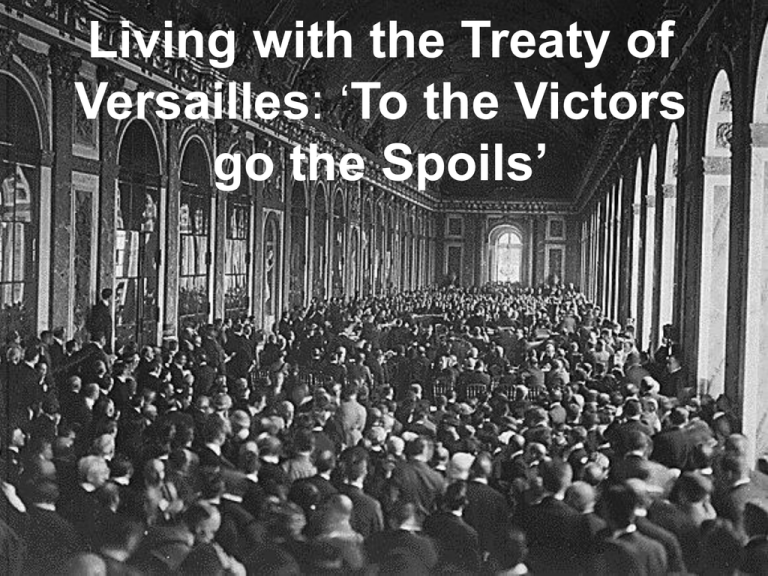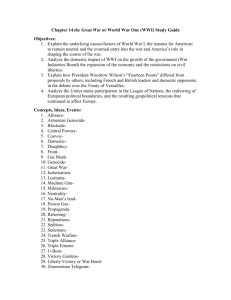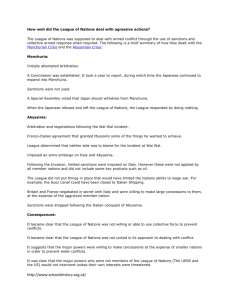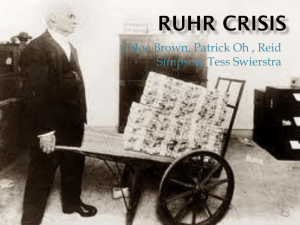The League of Nations
advertisement

Living with the Treaty of Versailles: ‘To the Victors go the Spoils’ The Six Months that Shaped the World: • After the armistice was signed in November, 1918 the world waited for 6 months for the final draft of the peace treaty • Representatives, including Prime Minister Robert Borden of Canada, met at Versailles near Paris to work out the terms of the Treaties to be signed with Germany, Austria and Bulgaria • All nations had some idea as to what they expected in peace – The general expectation was that Wilson’s 14 points would be abided by • The German public was led to believe that this was what the government had agreed to Woodrow Wilson The Why’s to Peace: • As a nearby neighbour of Germany who felt threatened, France needed a weakened and defeated Germany • France had suffered more than any other nation • Historically the losers of wars were punished • What ends up happening is that the stage is set for another World War Terms of the Treaty • • League of Nations Formed to aim for future peace The terms Versailles Peace treaty were not the same as the 14 points; they included: – – – – – – - • War Guilt Clause (Article 231 of the Treaty) Reparations of about $33 billion Removal of German speaking areas from Germany Loss of all German overseas colonies Commercial transport vessels: all oceanliners, locomotives, commercial motorvehicles, factory equipment and anything else that was not "nailed down" was confiscated. Germany’s ability to make war again was limited by restrictions on the size of its military (army less than 100 000 soldiers and navy less that 15000). Germany is not allowed to join the League of Nations. Because Germany was not allowed to take part in the negotiations of the treaty, the German government issued a protest to what it considered to be unfair demands, and soon afterwards withdrew from the proceedings – – Later a new German foreign minister, Hermann Müller, agreed to sign it in June, 1919. Later, Germans would not blame the military for the problems brought by the war but rather the civilian government which agreed to these terms which were perceived as a “stab in the back” of Germany The War Guilt Clause • Article 231 of the Treaty (the 'war guilt' clause) held Germany solely responsible for all 'loss and damage' suffered by the Allies during the war and provided the basis for reparations. • The total sum due was decided by an Inter-Allied Reparations Commission and was set at £6.6 Billion ($33 000 000 000). – This would have taken Germany until 1984 to pay! Major Losses: Other Key German Concessions: • • • • • • • • • • • • • • Germany has to cede the coal mines in the Saar-area to France. Germany has to cede all colonies: Togo en Cameroun, the territories in Eastand South-West Africa, islands in the Pacific and possessions in China. All German properties in foreign countries are confiscated. Germany has to cede all war material to the allies. German compulsory military service is abolished, as well as the General Staff. Germany is not allowed to have tanks, airplanes, submarines, large warships and poison gas. The total size of the Germany army is not to exceed 100 000 men. The German navy has a maximum of 15.000 men. Germany is allowed a total of 4 000 officers. Germany is not to take part in the League of Nations. Germany has to cede to the allies all seagoing ships. Furthermore one fourth of the fishing fleet and two fifths of the inland navigation fleet has to be ceded. Germany has to cede large amounts of machinery and building materials, trains and trucks. Germany has to deliver certain amounts of coal, chemicals, dye and fuel for many years. All German sub-ocean telegraph cables are confiscated. Ratification and Humiliation • The treaty was ratified (approved) by the League of Nations in January, 1920. In Germany, the treaty caused shock and humiliation that contributed to the collapse of the Weimar Republic in 1933, particularly because many Germans did not believe that they should accept the sole responsibility of Germany and its allies for starting the war. Reaction to the Treaty • The French population felt they had been slighted, and subsequently voted out Clemenceau at the next election • Britain as a whole was initially content, but then felt that the Treaty was too harsh – Of particular concern were Germany’s eastern frontiers, which were seen as a potential trouble spot for the future • For the USA, it was seen as Europe’s problem, and that overall, the Treaty was too harsh – Isolationism • Territorial adjustments were made with the aim of grouping together ethnic minorities in their own states, free from the domination of once powerful empires, specifically the Austro-Hungarian Empire and the Ottoman Empire – SELF DETERMINATION. • Secret treaties were also to be discouraged, and Britain and France greeted a call for the reduction in armaments by all nations with disapproval. – This was supposed to reduce, indirectly, the ability of navies to create blockades The Rest of Europe and ‘Self Determination’ The German Perception: By the Numbers: Legacy: • WWI fundamentally changed the shape and the perceptions of the world • Societal change – Socially this was a world where people felt that they had been through everything and that the old world was the world that led to war. As such this world was bad – Women’s Rights– in Canada, women were granted the right to vote in federal elections – Changes in: • • • • • Style Art Media Music Values Legacy: • Political Change: – Rise of democracies – Governments had almost complete control of the people (media/lack of democracy) this worried liberals – Radicalization of the political process • Anti establishment • Radicals on both the Left and Right of the political spectrum – Nationalism – Internationalism – League of Nations Legacy: • Economic Change – Nations had controlled their economies and realized the power of government involvement in economic practices, for example, in Canada, the government introduced Income Tax as a temporary measure during the war but it was never revoked! See a general relaxation of government control until the great depression – More of an emphasis early on social programs for veteran’s then a general decline in the view of this as being important – Rise of capitalism and link of this with democratic principles Invasion of the Ruhr - 1923 • The amount of these payments proved to be too great for the lagging German economy and in 1923 Germany defaulted and French and Belgian troops occupied the Ruhr in response • This occupation of the center of the German coal and steel industries both outraged Germany and put further strain on its economy – Arguably this was responsible for the German hyperinflation that year Despite these events the majority of Europe felt that this was a time of great optimism…. Why??? Dawes Plan 1923 Economic Reforms: • Dawes Plan 1923 – The Ruhr area was to be evacuated by Allied occupation troops. – Reparation payments would begin at 1 billion marks for the first year and should rise over a period of four years to 2.5 billion marks per year. – The German Reichsbank would be reorganized under Allied supervision. – Foreign loans (primarily from the United States) would be made available to Germany. – The plan went into effect in September 1924. • Why didn’t it work? – It made the German economy dependent on foreign markets and economies, such that problems to come in America – Great Depression would directly and severely hurt Germany as it would the rest of the western world, which was subject to debt repayments for loans of American dollars. • Young plan 1929-1930 • Hoover Moratorium 1931-32 The Hoover Moratorium 1931-32 • Between agreement and adoption of the Young Plan came the Wall Street Crash of 1929, of which the main consequences were twofold. – The American Banking system had to recall money from Europe and cancel the credits that made possible the Young Plan – Moreover, the downfall of imports and exports affected the rest of the world. By 1933, almost two-thirds of world trade had vanished • A new trade policy was set with the Hawley-Smoot custom duty • Unemployment soared to 33.7% in 1931 in Germany, and 40% in 1932. • Under such circumstances, US President Herbert Hoover issued a public statement that proposed a one-year moratorium of the payments – He managed to assemble support for the moratorium from 15 nations, but the adoption of the moratorium did little to slow economic decline in Europe Political Agreements: • Locarno Pact 1925 – Determined and agreed to Germany’s Boarders – Eliminated the one ‘reason’ for war • Kellogg-Briand Pact 1928 – Rejected the concept that war was ‘sometimes necessary’ – Endorsement for the use of diplomacy Social Reaction: • Radical Revolutions suppressed – Socialist – Fascists – Hitler’s Beer Hall Putsch • Rise of Democracy The League of Nations The 14th Point • Wilson's final point was perhaps the most visionary: – XIV. A general association of nations • Point 14 called for a multilateral international association of nations to enforce the peace, foreshadowing the League of Nations (and, after the Second World War, the United Nations). • The treaty had provided for the creation of the League of Nations, a major goal of U.S. President Woodrow Wilson. • The League of Nations was intended to arbitrate international disputes and thereby avoid future wars. • Only three of Wilson's Fourteen Points were realized, since Wilson was compelled to compromise with Clemenceau, Lloyd George and Orlando on some points in exchange for retaining approval of the "fourteenth point," the League of Nations. Aims of the League: • Stop war and international aggression by discussing problems • Disarmament • Encourage cooperation amongst nations • Improve economic and social conditions Membership • 42 members originally • USA refused to join the League – – Isolationism as evidenced by the Senate’s refusal to ratify the Treaty of Versailles • Viewed as a “club for the victorious” – Defeated countries could not join • Germany – Russia excluded because of Bolshevism • 59 members by the 1930’s; – Bulgaria (1920), Austria (1920), Hungary (1922), Germany (1926), Mexico (1931), Turkey (1932), and the USSR (1934) • Japan, Germany and USSR joined and then resigned when decisions were against them – Japan for Invasion of Manchuria – Germany because of disagreement with the Arms Limitations Conference – Russia over the invasion of Finland Structure • The Assembly – Each country one vote – Met once a year • The Council – Composed of four permanent members (Great Britain, France, Italy, Japan) – Temporary members – The Council met several times a year and during emergencies. – All decisions had to be unanimous • Permanent Court of International Justice – Based at The Hague. – The Court was meant to be a forum where disputes could be settled peacefully. – The court had no power of enforcement. • The Secretariat – Kept records for the League and acted as a permanent civil service Powers of the League • SANCTIONS: – Verbal Sanctions: Put international pressure on country – Economic Sanctions: Refuse to trade – Military Sanctions: Send in troops • Members were not obligated to enforce sanctions • Refer disputes to the World Court for resolution Strengths of the League • Many countries wanted peace so they supported the League • Settled disputes among minor countries in the 1920’s (between Yugoslavia & Albania, Sweden & Finland and Poland & Germany) • Helped improve the role of women, stop slave labour, campaigned to stop spread of disease, and drugs. • Addressed social issues at the international level for the first time by informing others, discussing and coming to agreements. Case study of a failure of the League: The crisis over Abyssinia, (Ethiopia) 1935 1937 "It [a League of Nations] will only result in failure and the longer that failure is postponed the more certain it is that this country will have been lulled to sleep. It will put a very strong lever into the hands of the well-meaning idealists who are to be found in almost every Government, who deprecate expenditure on armaments, and, in the course of time, it will almost certainly result in this country being caught at a disadvantage“ Maurice Hankey British Secretary of Cabinet 1919 Background to events • Abyssinia : An independent country ruled by Haile Selassie, the only independent black country in Africa. In 1896 its army had defeated an Italian invasion. • Mussolini : Fascist dictator of Italy, was determined to build an Empire. He also wanted revenge for defeat of 1896. Timeline of Events • December 1934 - Italian troops provoke a clash at Wal Wal • October 1935 - Italian invasion begins • December 1935 - Britain and France produce Hoare-Laval Plan. – Large parts of Abyssinia to be given to Italy in return for Italian withdrawal. – Public outcry—plan abandoned • May 1936 Italian conquest complete The League: actions and results • Dec 1934 League offers arbitration • Jan-Feb 1935 debates its response • May-Sept sets up a five power commission • Oct 1935 Italy condemned: limited economic sanctions imposed • Rejected by Italy • No further action • Abyssinia rejects proposals • Sanctions did not include food, coal, rubber, or oil. The Suez Canal was not closed. The League: actions and results • March 1936 - Oil embargo threatened • No impact: Italy completed conquest – Hitler noted weakness of the League and remilitarize the Rhineland (March 1936) • June 1936 - Haile Selassie addressed Assembly of League calling for help • No additional action by League The League: actions and results • July 1936 - sanctions against Italy were abandoned • Italy – Kept Abyssinia – Formed an alliance with Germany – Left the League, 1937 Why did the League of Nations Fail? Apart from the explicit failures in the 1930’s (Abyssinia and Manchuria), the League had too many inherent weaknesses right from the start: Why did the League fail? • First and foremost the absence of the USA and other major powers meant that this world organization was really controlled by only Britain and France. – Germany did not join until 1926 – Russia not until 1934 when Germany left – Japan left in 1933 – Italy in 1937 • The rejection of both the peace treaties and the League by the US Congress really undermined the political, economic and military power of the League. Why did the League fail? • Clearly the absence of the USA, the world’s foremost economic power, meant that economic sanctions could never really be properly applied. In any event history has shown that economic sanctions can be circumvented and take a long time to work. Why the League failed French and British self interest Absent powers - USA Ineffective sanctions Lack of enforcement of decisions Unfair treaty Reaching decisions unanimously European club Conclusion: • The League of Nations was a noble idea, but like many ideals it was unable to work in the real world • Of course none of its weaknesses necessarily doomed the League to failure, provided all the members were prepared to refrain from aggression and accept its decisions • The real explanation for the failure of the League was that aggressive states such as Japan, Italy and Germany were prepared to openly defy it, while League members, like Britain and France, were not prepared to risk another war to support it "failed ultimately because of the reluctance of nearly all the nations in Europe to proceed to what I might call military sanctions.... [T]he real reason, or the main reason, was that we discovered in the process of weeks that there was no country except the aggressor country which was ready for war.... [I]f collective action is to be a reality and not merely a thing to be talked about, it means not only that every country is to be ready for war; but must be ready to go to war at once. That is a terrible thing, but it is an essential part of collective security." Stanley Baldwin British Prime Minister 1936







